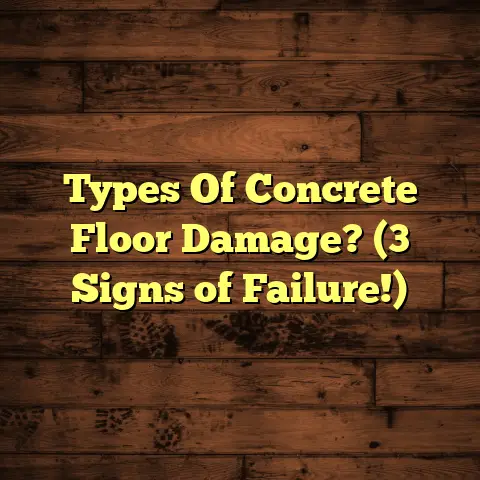Maintain Engineered Wood Floors (3 Pro Secrets!)
Did you know that engineered wood flooring is becoming increasingly popular?
According to the National Wood Flooring Association (NWFA), engineered wood has seen a 25% increase in consumer preference over solid wood in the last five years alone.
That’s huge!
Why? Because it offers a fantastic blend of beauty, durability, and cost-effectiveness.
But here’s the catch: even the best engineered wood floor needs proper TLC to keep it looking its best.
I’m here to share my secrets as a flooring contractor to help you keep your floors in tip-top shape.
Understanding Engineered Wood Floors
First, let’s get clear on what engineered wood flooring is.
It’s not solid wood, but it’s also not laminate.
Think of it as a multi-layered sandwich: a thin layer of real hardwood veneer on top, bonded to a core of plywood or high-density fiberboard (HDF).
This construction gives it some serious advantages.
- Moisture Resistance: The layered construction makes it less prone to warping and expanding in humid conditions compared to solid wood.
- Installation Ease: Many engineered wood floors come with click-lock systems, making DIY installation a breeze.
- Aesthetic Appeal: You get the look and feel of real hardwood without the hefty price tag or the same level of maintenance.
The market is booming, and for good reason. You get a great-looking floor that’s built to last, without breaking the bank.
The Importance of Maintenance
Now, why is maintenance so vital?
Think of your engineered wood floor as an investment.
You wouldn’t buy a car and never change the oil, right?
The same goes for your floors.
Proper care preserves their beauty, extends their lifespan, and saves you money in the long run.
I’ve seen it all: scratches from pets, fading from sunlight, and warping from moisture.
According to a recent survey by Flooring Today, 68% of homeowners expressed concerns about maintaining the appearance of their wood floors.
That tells me that people want their floors to look good and last long, but they’re not always sure how to achieve it.
That’s where I come in.
Pro Secret #1 – Daily Cleaning Techniques
Let’s start with the basics: daily cleaning.
This is the foundation of any good floor maintenance plan.
Recommended Tools
- Microfiber Mops: These are my go-to for everyday cleaning. They pick up dust and dirt without scratching the surface.
- Soft-Bristle Brooms: For quick sweeps, a soft-bristle broom is perfect. Avoid brooms with stiff bristles, as they can damage the finish.
- Vacuum with a Floor Brush Attachment: A vacuum can be effective, but make sure to use a floor brush attachment to prevent scratches.
Safe Cleaning Solutions
- pH-Neutral Cleaners: These are specially formulated for wood floors and won’t damage the finish. I recommend Bona or Armstrong Hardwood & Laminate Floor Cleaner.
- DIY Options: A simple solution of water and a few drops of dish soap can work in a pinch. Just be sure to use it sparingly and dry the floor thoroughly.
Cleaning Frequency & Tips
- Daily Sweeping or Dusting: This prevents dirt and grit from building up and scratching the floor.
- Weekly Mopping: Mop your floors once a week, or more often if needed. Always wring out the mop thoroughly to avoid excessive water.
- Entryway Mats: Place mats at entrances to trap dirt and moisture before they reach your floors.
Avoiding Harsh Chemicals & Excessive Water
This is crucial.
Never use abrasive cleaners, bleach, ammonia, or anything that isn’t specifically designed for wood floors.
Excessive water can seep into the seams and cause warping.
Always use a damp mop, not a soaking wet one, and dry the floor immediately after mopping.
Pro Secret #2 – Preventative Measures
Now, let’s talk about prevention.
An ounce of prevention is worth a pound of cure, as they say.
These simple steps can go a long way in protecting your floors.
Area Rugs & Mats
- High-Traffic Areas: Place rugs in hallways, entryways, and living rooms to protect the floors from wear and tear.
- Under Furniture: Use rugs under tables and chairs to prevent scratches from furniture legs.
Furniture Pads
- Under All Furniture Legs: These little pads are lifesavers. They prevent scratches and dents when moving furniture. I recommend felt pads for hard surfaces.
Environmental Controls
- Humidity Regulation: Keep your home’s humidity level between 30% and 50%. Use a humidifier or dehumidifier as needed.
- Temperature Regulation: Avoid extreme temperature fluctuations, as they can damage the wood. Keep your home’s temperature consistent.
Lifestyle Changes
- Take Off Your Shoes: This is the easiest way to prevent dirt and grit from being tracked onto your floors.
- Trim Your Pets’ Nails: Long nails can scratch the finish.
- Clean Up Spills Immediately: Don’t let spills sit on the floor for too long, as they can cause staining or warping.
Common Mistakes & How to Avoid Them
- Using the Wrong Cleaning Products: Always use pH-neutral cleaners specifically designed for wood floors.
- Over-Wetting the Floor: Use a damp mop, not a soaking wet one, and dry the floor immediately.
- Ignoring Scratches: Address scratches as soon as possible to prevent them from getting worse.
Pro Secret #3 – Restorative Care
Even with the best daily cleaning and preventative measures, your engineered wood floors may eventually show signs of wear and tear.
That’s where restorative care comes in.
Buffing Out Scratches
- Minor Scratches: For minor scratches, you can use a scratch concealer or a buffing compound. Apply the product according to the manufacturer’s instructions.
- Deeper Scratches: For deeper scratches, you may need to sand the area and apply a new coat of finish. I recommend hiring a professional for this.
Refinishing
- When to Consider Refinishing: If your floors are heavily scratched, faded, or worn, refinishing may be necessary. This involves sanding down the old finish and applying a new one.
- How to Do It Safely: Refinishing can be a messy and time-consuming process. I recommend hiring a professional to ensure it’s done correctly.
- DIY Refinishing: If you’re feeling ambitious, you can refinish your floors yourself. Just be sure to research the process thoroughly and follow the instructions carefully.
Professional Services
- When to Call a Pro: If you’re unsure about any aspect of floor maintenance, it’s always best to call a professional. We have the tools, knowledge, and experience to get the job done right.
- What to Expect: A professional floor contractor can assess the condition of your floors, recommend the best course of action, and provide a detailed estimate.
Maintenance Products
- Sealants: Sealants protect the floor from moisture and stains. Apply a sealant every few years, or as needed.
- Waxes: Waxes add a layer of protection and shine to the floor. Apply wax every few months, or as needed.
Identifying When a Floor Needs More Than Just Cleaning
- Deep Scratches: If you can’t buff out the scratches, it’s time to consider refinishing.
- Fading: If the floor is faded, refinishing may be necessary to restore its color.
- Warping: If the floor is warped, it may need to be replaced.
Conclusion
So, there you have it: my three pro secrets for maintaining engineered wood floors:
- Daily cleaning: Keep your floors free of dirt and debris.
- Preventative measures: Protect your floors from damage.
- Restorative care: Address wear and tear as soon as possible.
By investing a little time and effort into maintaining your engineered wood floors, you can ensure they remain beautiful and functional for years to come.
Don’t let your floors become a source of stress.
Embrace these maintenance practices, and enjoy the beauty and durability of your engineered wood floors for years to come!





